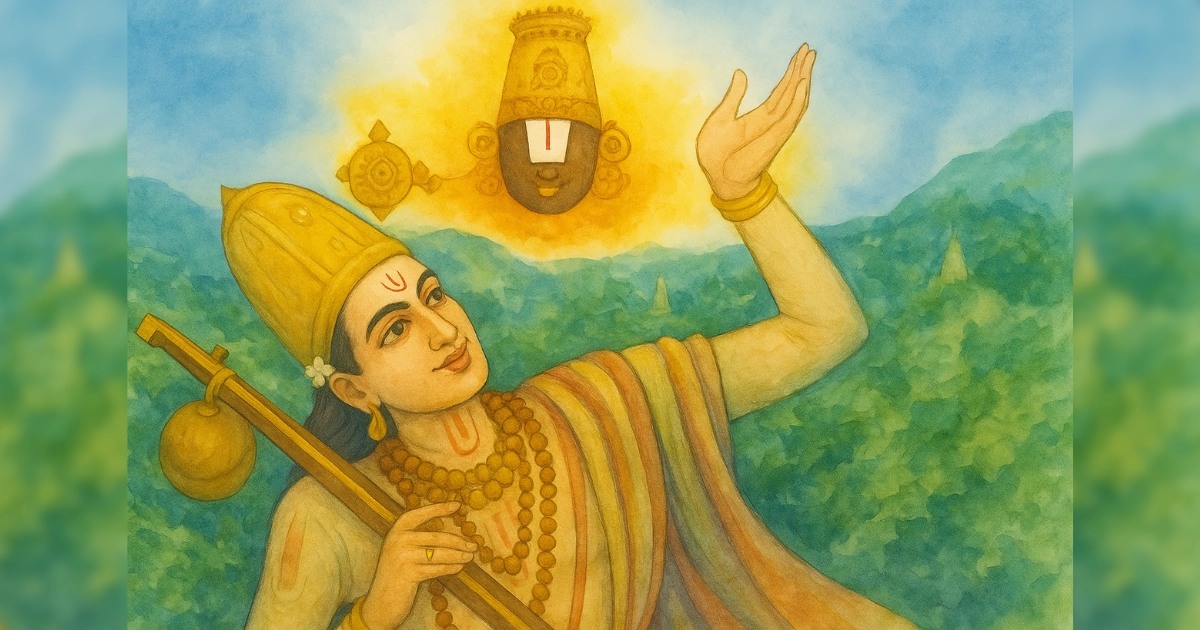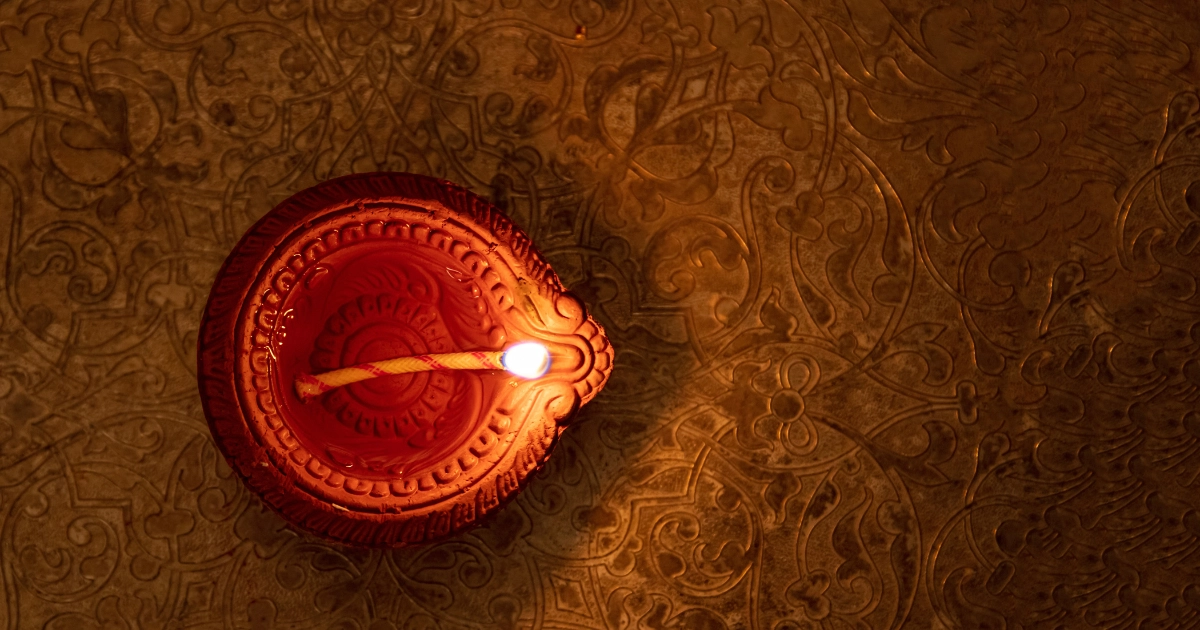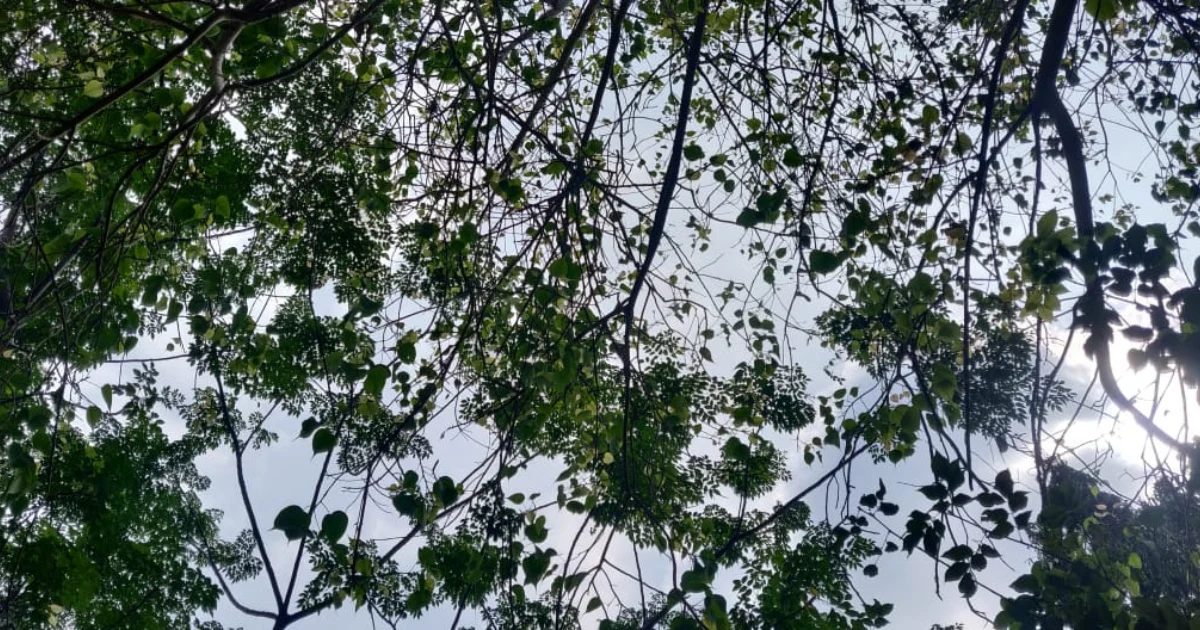This year marks the 617th birth anniversary of the inimitable bhakti poet and saint, Annamācārya. His timeless compositions to the Lord of the Hill embody bhakti and philosophy and evoke an unparalleled transcendental glory. Of all the saints that emphasised the bhakti-mārga that this sacred land has produced, Annamācārya shines among them as a resplendent gem. His compositions are replete with poetry and sublime in their exposition of high philosophical truths.
Tāḷḷapāka Annamācārya lived at the great hilltop shrine of Tirupati in Andhra Pradesh, in the fifteenth century, and is said to have composed a pādam a day for the god of this temple, Veṅkaṭeśvara, Lord Viṣṇu. Late in his lifetime, or not long after his death, about thirteen thousand of these were inscribed on copper plates by his son (who also composed his biography) and stored in a special vault called saṅkīrtana bhaṇḍāram inside the Tirumala temple along with a few at Ahobhilam and Śrīraṅgam. The copper plates were discovered by the TTD (Tirumala Tirupati Devasthanams) in the year 1922: 363 containing ādhyātma compositions, 1921 containing śriṅgāra saṅkīrtanas, and others inscribed with the compositions of his son and grandson. The hagiographical tradition of Tirupati asserts that this surviving corpus is less than half of Annamayya’s original oeuvre. These poems are the Tirupati temple’s greatest treasure.
At the age of 16, Tāḷḷapāka Annamācārya had a vision of the Lord of the Seven Hills through a dream. He woke up with a composition on his mind, befittingly in the rāga Bhūpālam:
I beheld in my dream the Lord of Śri Veṅkaṭādri,
The father of all worlds...
He then joined a group of devotees on a pilgrimage to Tirupati and began to climb up the Tirumala Hill. On his way he composed several songs, and in his lifetime, a total of about thirty two thousand. While on the path up the hill, he rested on a ledge in a bamboo grove, still wearing the sandals he was wearing when he left home. The Goddess Alamelumaṅga appeared in his dream, manifested from the depths of his soul, Her presence glowing in his consciousness. The Goddess told him to remove his sandals, telling him that he would not have grown tired if he had climbed without them. She also gave him prasādam, and promised that he would be blessed by Her consort Śri Veṅkaṭeśvara. Annamayya awoke and composed a śataka (one hundred verses of praise) dedicated to her on the spot to express his devotion. He then hurried up the path, eager to receive the Lord’s darśana. Upon gazing at Veṅkaṭeśvara, he felt an overflowing bliss, and broke out into song, expressing his undying devotion. The next day, while the doors to the inner sanctum were closed, Annamayya sang a śatakam to Lord Veṅkaṭeśvara and the doors of the sanctum were thrown open for him. Annamayya dedicated the rest of his life to expressing this devotion. Though born to a smārta brahmin family, he embraced the Vaiṣṇava sāmpradāya of Vedānta Deśikan soon thereafter, initiated by his guru Śatakopayati of the Ahobhila Maṭha.
In one of his compositions originally set to rāga Nāṭa, he speaks of the impermanence and fleeting nature of śriṅgāra or erotic love -
Where is that love, that intimacy, those sweet nothings...
Like lightning that appears and disappears, love also vanishes.
Just as water in a mirage is an illusion, love is an illusion.
It is like wealth found in a dream that you do not have when you wake up,
Only one thing is stable, permanent and eternal,
that is the thought of Śri Veṅkaṭeśvara...
In one of his ādhyātma (spiritual) compositions, he proclaims:
enta mātramuna euvaru dalacina anta mātrame nīvu...
The larger composition which translates to:
You are what people worship you as.
The Vaiṣṇavas worship you as Viṣṇu.
Whatever one thinks of you, that you become, O Lord,
isn’t it obvious that the size of the pancake depends on the quantity of batter?
The Vaiṣṇavas lovingly adore you as Viṣṇu;
while those who profess Vendānta hail you as Parabrahman;
Devout Śaivites look on you as Śiva;
and the Kapālikas sing your praises as Ādi Bhairava.
The Śaktas worship you as the goddess Śakti;
and the darśanas visualize you in countless ways.
To those that show little regard, you look small;
and to those that think nobly of you, you appear lofty...
The weakness does not lie with you;
You are like a lotus in the pond that rises and falls with the level of the water.
The waters of the river Ganga alone are to be found in all the wells by the riverside...
You hold us under your sway,
O Lord of Veṅkaṭādri, I surrender myself to you,
and this to me is the ultimate reality.
Annamācārya effectively created and popularised a new genre, the short pādam (also saṅkīrtana, “poem of praise”), that spread throughout the Telugu and Tamil regions and later became a major vehicle for Carnatic musical composition. The pādas which Annamayya composed consisted of lyrics following specific syntactic rules of poetry, such as the alliterative first syllables of couplets, a tradition which Telugu lyricists and melodists who came after him echoed.
Especially evident in Annamācārya’s compositions, rasa gives bhakti the framework for the expression of culturally creative artistry — the soul makes beauty dedicated to God — and its metaphysics, the soul blissfully realizing God as the manifestation of this beauty. The sacred attractor in this whole spiritual process is a sort of beautiful bliss. Philosopher J. L. Mehta wrote of rasa and bhakti as follows:
Bhakti...implies the generation of a wholeness in our total being and as such is a total response of the reality disclosed by the experience of rasas...Contrary to modern, Western, subjectivistic and man-centred philosophies of life, feeling...must be understood...as a mode of man's relationship to Being...Feeling has its own sight, that through it a disclosure of what is takes place...in which truth, reality and value are no longer separable...Understood in this metaphysical, non-psychological sense of feeling, bhakti represents man's primordial relationship to being...The ultimate refuge in his search for wholeness.
Annamācārya, through his song, embodies this melding of beauty and bhakti, aesthetics and higher truths as a consciousness-elevating force.
One of Annamācārya’s sweetest compositions, and one that truly exhibits his poetic genius is Muddugāre Yaśodā, which compares little Kṛṣṇa’s attributes and exploits to the navaratnas or the nine gems. Set to the rāga Kurinji, it is lyrically and poetically rich with alliteration and allegory, yet playful and endearing.
A translation of the lyrics follows:
Muddugāre Yaśodā
The son of Devakī, child of ineffable glory
He is a pearl to the beautiful Yaśodā
He is a ruby in the palms of the gopīs
He is the vajra (diamond) to obstinate Kaṁsa
He is the lustrous emerald to all the three worlds
He is the little Kṛṣṇa that is within each of us.
The son of Devakī, child of indescribable glory
He is a pearl to Yaśodā of great beauty
His red lips are like coral to the amorous Rukmiṇī;
He is the garnet to Govardhana,
He is the cat’s eye in between the eternal śankha and cakra
The lotus-eyed one who protects us when sought.
The son of Devakī, child of untellable glory
He is a pearl to Yaśodā of great beauty
He is yellow sapphire on the hoods of Kāliṅga
He is the blue sapphire that reigns over the Veṅkaṭādri hill,
Among the treasures of the milky ocean,
He stands out as a divine jewel
He is the Padmanābha who roams around like a little boy.
The son of Devakī, child of ineffable glory
He is a pearl to the beautiful Yaśodā.
Annamācārya, as one of the pillars of the bhakti movement that had already taken hold across the country during his time, also wrote other works of poetry, including the Veńkaṭācala-māhātmya in Sanskrit; Śriṅgāra-manjari, a poem of a nāyikā's love for Veṅkaṭeśvara; a Telugu Rāmāyaṇa, twelve śatakas, and a treatise in Sanskrit on music: Saṅkīrtana Lakṣaṇam, which is lost, though a translation in Telugu written by his grandson Chinnana exists. Annamācārya passed away in 1503 and his son and grandson, both musicians in their own right, preserved the songs, gave endowments, and ensured that the songs lived on in temples — but due to the absence of a guru-ṣiṣya parampara to carry on the tradition and the music, it was lost to us altogether. With respect to Annamācārya’s compositions, we only know of the lyrics and the name of the rāga in which it was composed, but the music itself, or rather, the manner in which these compositions were rendered by him or in his time, is unknown. After 1949, when the existence of the compositions was popularised, famous Carnātic musicians set them to music and began to disseminate them through various mediums, with the help of the TTD.
Annamācārya composed with the singular determination to propagate bhakti to the Lord of Veṅkaṭam among the lay folk, and offered every one of his compositions to the lotus feet of the Lord. He consciously distilled lofty philosophy into the most simple and colloquial of language, in order to have a more universal appeal. Hailing from an agricultural family, the rustic ruralism and innocence was evident in his songs. As scholar and musicologist Dr. P. Venugopala Rao states in his book ‘Flowers at His Feet’, language was a tool for Annamācārya to express his intense bhakti: “Annamayya is a rare combination of great scholarship and intense devotion.”
References
- Vēṇugōpāla Rāvu, Pappu. Flowers at His Feet: An Insight Into Annamacharya’s Compositions. India, Pappus Academic & Cultural Trust, 2006.
- God on the Hill: Temple Poems from Tirupati. United States, Oxford University Press, 2005.
- Annamācārya. Humble Offerings: Translation of Sri Annamacharya Compositions (108 Sankeerthanas). India: Tirumala Tirupati Devasthanams, 2014.
- Purandaradāsa., Annamācārya., Kanakadāsa., Jackson, William Joseph. Songs of Three Great South Indian Saints. India: Oxford University Press, 1998.






